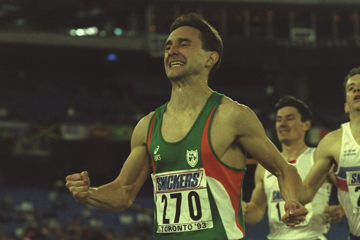For the second half of the 1980s, Nelli Cooman was the most dynamic 60m runner on the planet. Here we catch up with the Flying Dutchwoman to reminisce about her gold medal successes at the 1987 and 1989 IAAF World Indoor Championships.
Why do you believe you were such a great indoor runner?
I had one of the best starts in the world and one of the best coaches in the world in Henk Kraayenhof, who is a scientist. A real nerd. My first indoor competition came aged 18. I loved the intimate nature of indoor running and how close the spectators were to the action. I also benefited from having 80% fast-twitch fibres. I was like a Ferrari when the gun went.
In 1987 you had enjoyed a great indoor season, winning the European indoor 60m title. What was your expectation going into the inaugural IAAF World Indoor Championships?
As it was the first World Indoor Championships I really wanted to be there and a big motivation for me was to become the first Dutch champion. A week or so before the event I had a big problem with the inside of my leg. I had sat crossed-legged at a sponsors dinner in Los Angeles and I think that’s when I picked up the injury. Thankfully, my coach was a huge help. He helped me psychologically. Rather than focus on the injury, he made sure I spent plenty of time reading books and he even bought me a computer game – Pac Man – as a distraction from the injury. By the time I arrived at the World Indoors, my mind was strong. I did not think about the injury.
It was an incredibly close women’s 60m final in Indianapolis as just three thousandths of a second separated you from Canada’s Angella Issajenko (both athletes were given a time of 7.08). What do you recall of the race?
I remember that my start was okay. I felt I struggled a little in the middle of the race but I timed the finish well. After the race, it was still undecided who had secured gold, although I recall telling the Dutch journalists I had won. As an athlete, my instinct was that I had taken it. The Dutch journalists thought Issajenko had won, but I told them they needed some new glasses.
(Note: Issajenko was later disqualified for doping and Bulgaria’s Anelia Nuneva, who ran 7.10, was upgraded to silver.)
When were you confirmed as the gold medallist, what were your emotions?
We had to wait for about an hour. I had won by three thousandths of a second – just a nipple as we say in Dutch. I was obviously very pleased to win although that day my mind was elsewhere. A ferry named the Herald of Free Enterprise had capsized near the Belgian port of Zeebrugge, killing 193 people. I was very concerned. That day my mind was also in Europe.
Two years later, you returned to defend your world indoor title in Budapest. Did you feel any additional pressure as defending champion?
Yes, I did feel extra pressure. I had separated from my coach Henk, who was now coaching one of my big rivals, Merlene Ottey. I went into Budapest determined to show my coach that I am a big girl now and I can win without him.
This time you prevailed by a far more comfortable margin – 0.02 – than in Indianapolis. What were your memories of the competition?
I was up against a very strong field with Merlene and US sprinter Gwen Torrence and I recall picking up a cold during the event. For the final I had a temperature of 39C, I was coughing and felt ill. I was so nervous on the starting blocks. I don’t remember too much of the race but as I crossed the line I felt so happy. I was so relieved I had won and I just remember thinking I am a big girl now. At that time, I was the world record-holder and I had enjoyed one of best season indoors, but in Budapest I proved to the world I was the best.
You competed at three more World Indoor Championships (in 1991, 1993 and 1995). What do you recall of those competitions?
Seville was awful (she failed to advance from the 60m semi-final, running 7.28) and at the time I was going through a lot of personal problems. I competed in 1993 (where she reached the 60m final and finished seventh) but I had a knee injury which required surgery after the championships. I remember saying as soon as I had finished for an airplane to take me home straight away because I couldn’t walk. I have better memories of 1995. I was once more coached by Henk and I managed to finish sixth (in 7.17).
Why was the IAAF World Indoor Championships so special to you?
It is an intimate event, like one big family. It's also an opportunity for the specialist 60m runners. But to excel in the 60m, you cannot make any mistakes. Everything has to be correct.
What are you doing today?
I work a lot with the local government here in the Netherlands with youth and the Special Olympics. I carry out a lot of charity work. It is nice to be able to give back. I have two daughters; a 33-year-old adopted daughter and Ronéll, who is 18. Only last year she started running and is also coached by Henk just like I was.
If you could give a tip for people running the 60m, what would it be and why?
The start and the finish are the two most important elements. You have to run like a tiger catching its prey.
Steve Landells for the IAAF





